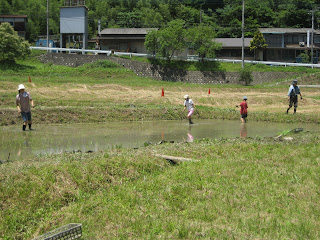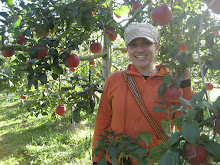After the previous blog entry, I can hear the collective readers’ cry of, “Please, Mandy, tell us how you plant rice! It sounds so interesting!” Well, I’d hate to disappoint my readers, so your prayers have been answered. Here is my rendition of how you actually go about the rice planting process.
Okay, first you need a rice paddy……hee hee, I won’t go that indepth. I think Mayumi and Mocchan do their rice planting a bit more of the old fashioned way. I’ve seem some people out in small tractors in their rice paddies churning the mud. I don’t think there is any other way to actually plant the rice than do it by hand, but I’m sure there are some more “high tech” methods of measuring out your rows, weeding, etc. Mayumi and Mocchan’s method of measuring rows is to use an inch-diameter-thick piece of wood about a yard long that has intervals (of what kind of distance, I don’t know) marked by colored tape. You start at one side of the rice paddy and measure out rows kind of the same way you put up lane lines in a swimming pool. Put the measuring stick against one “wall” of the rice paddy and mark your rows using thick twine wrapped around sticks on either end. Unwind the twine as far as you need to go to stretch across the length of the rice paddy, then shove the sticks on either end into the mud. Just make sure the twine is above the water line so you know where the heck you’re supposed to go with the rice plants. We set up maybe 4-5 row markers at one time, so you kind of plant three rows at a time between two row markers- one to the immediate left of the twine, one in between to twine markers, and one to the immediate right of the second row marker.
The rice plants come in square clumps that look like sod people use in the States to plant new grass in their yard. It seems easiest to have someone first go through the squares to pull the individual rice plants apart (and get rid of bad plants). After the plants have been separated, you grab a handful or two, take 2-3 plants together, and just push them lightly into the mud, where they suction quite easily. Leave about an adult’s foot-length in-between each rice plant on all sides, and repeat. And that’s it! The tricky part about rice planting is not losing your balance in the mud.

There were 9 of us on the rice planting day, although 2 of those 9 were under 5-years of age, so they and one of their parents took up the task of keeping us well-informed on the biology of the rice paddy and nearby creek, which primarily consisted of delighted squeals when someone found a frog, or lizard or extraordinarily large tadpole. In the end there were 6 of us that did most of the planting, including two 10-year olds who must hold the record for speed-rice planting. They were definitely putting me to shame! Half the rice paddy was already planted, so we spent about 3 hours finishing up the other half.
On weeding day, I think there were nearly 10 people on-hand, so we were able to spend a very thorough 2 hours weeding the 3 terraces of rice paddies (none of which are really all that big). One of my first-grade junior high school students came with her mother and baby sister. It's always awesome to spend time with students and their families outside of school.
Fun times in Tokigawa!


